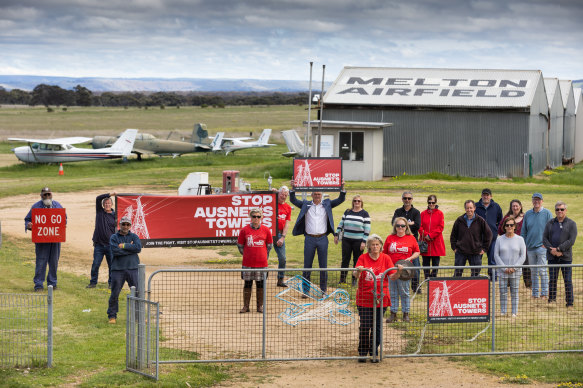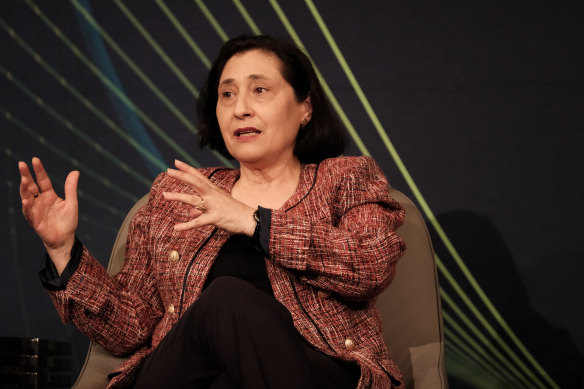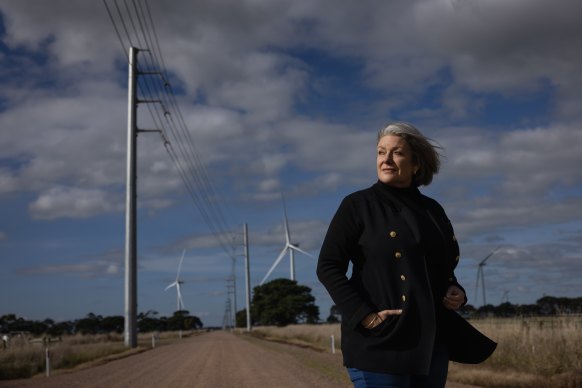- Exclusive
- National
- Victoria
- Renewables
This was published 10 months ago
Power move: Andrews government seizes control of renewable energy planning
By Josh Gordon and Benjamin Preiss
The state government has seized control of the planning process for renewable energy transmission projects in a bid to prevent a backlash from communities forced to accept the massive power lines needed for Victoria’s ambitious wind and solar agenda.
Under the changes, the Australian Energy Market Operator (AEMO), which controls the electricity grid, will no longer be responsible for planning decisions and community consultation linked to new energy infrastructure projects.

A protest against proposed power lines on the outskirts of Melton during last year’s state election campaign.Credit: Jason South
Those responsibilities will instead shift to VicGrid, a state government agency charged with ensuring communities, landholders, Indigenous groups and others “are consulted on these major projects from start to finish” and are kept “at the heart of the process”.
Energy Minister Lily D’Ambrosio said it was vital regional communities were included in plans.
“This is a once-in-a-generation opportunity to reform the way we plan our energy infrastructure with genuine consultation with communities and industry at the heart of the process,” she said.
The change follows mounting anger in regional communities caught in the path of big transmission projects, some of which are already fighting the prospect of long stretches of large above-ground cables hanging from towers up to 85 metres high.

Victorian Energy Minister Lily D’Ambrosio.Credit: Oscar Colman
AEMO has become increasingly vocal about the need for hundreds of kilometres of new transmission lines to strengthen the reliability of the grid after the closure of the state’s three remaining coal-fired power plants within the next decade. The Andrews government is promising to be 65 per cent reliant on renewable energy by 2030 and 95 per cent reliant by 2035.
But the push is already proving politically difficult.
AEMO chief executive Daniel Westerman has warned that the transmission links running between states are now “maxing out”, suggesting this already limited the scope for investing in renewables. In a recent speech, Westerman warned that between January and March, Victoria’s electricity links to NSW were stretched to their limits 42 per cent of the time.
“Parts of our energy highway are at gridlock,” he said.
Three transmission projects are already on the cards in Victoria, involving a total of 504 kilometres of new high-voltage power lines. The projects are the Western Renewables Link (WRL), designed to carry energy from wind and solar farms in western Victoria; the VNI-West project connecting the Western Renewables Link to the NSW Riverina region; and the Marinus Link to Tasmania.
AEMO will continue managing the planning for those projects, and the new rules only apply to future energy infrastructure, including transmission lines to connect any offshore wind projects and renewable energy generated by the government’s flagship State Electricity Commission.
Moyne Shire Mayor Karen Foster said she was heartened by the government’s commitment to establishing local reference groups and having a physical presence in communities that would host the infrastructure.
“Any measure that looks to involve people and communities impacted by these industrial power lines is a good one,” she said.

Moyne Shire Mayor Karen Foster says her community bears the infrastructure brunt of Victoria’s move to renewable energy.Credit: Nicole Cleary
Foster hoped the new policy would also consider lines that “crisscross” the Moyne region to connect individual wind farms to the electricity grid.
She wants the government to require lines be placed underground or co-located with existing infrastructure wherever possible.
The shire, in south-west Victoria, already has at least six wind farms, more than 300 turbines and many more under construction or proposed.
Foster said renewable energy was the way of the future, but Moyne communities bore the brunt of power generation for the rest of Victoria through the “industrialisation of our rural landscapes”.
Victorian Farmers Federation president Emma Germano welcomed the framework and said it should be applied to both VNI-West and the WRL.
“There’s absolutely time to pause and ensure we’re getting it right,” she said.
Germano was also concerned the framework didn’t properly address land access and compensation.
A state government report provided to The Age mapping out the changes warned that planning rules needed to cope with the rapid transition to renewable energy were “too slow and too reactive” to keep pace. The last of Victoria’s ageing coal-fired power stations are to close over the next decade.
“Existing transmission planning processes do not adequately incorporate community, land use and environmental considerations, including local economic benefits, leading to a lack of community acceptance for transmission projects,” the report said.
It said community opposition to the WRL highlighted the need to better engage communities early in the planning process to avoid delays and higher delivery costs. It warned that even a two-year delay to transmission projects would likely add an extra $1500 to Victorian household energy bills over 15 years.
But the report also said there was a perceived lack of fairness in the current planning process that regional areas have been forced to bear the impacts of new energy infrastructure, while cities benefited.
Nicola Falcon, AEMO’s manager of Victorian planning, said the operator supported the Victorian government’s new planning rules framework. She said community support and social licence were vital for the timely delivery of essential transmission investment.
Get to the heart of what’s happening with climate change and the environment. Our fortnightly Environment newsletter brings you the news, the issues and the solutions. Sign up here.